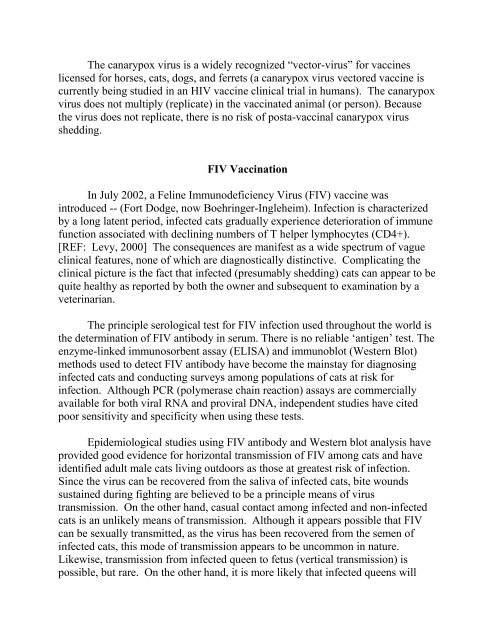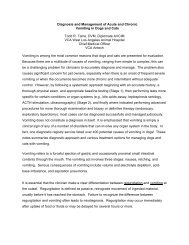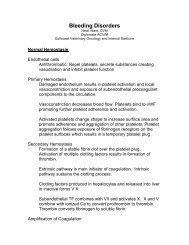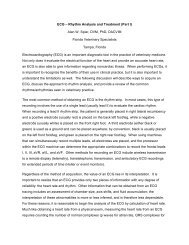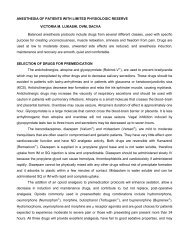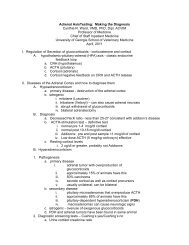Feline Leukemia Virus and Feline Immunodeficiency Virus ...
Feline Leukemia Virus and Feline Immunodeficiency Virus ...
Feline Leukemia Virus and Feline Immunodeficiency Virus ...
- No tags were found...
Create successful ePaper yourself
Turn your PDF publications into a flip-book with our unique Google optimized e-Paper software.
The canarypox virus is a widely recognized “vector-virus” for vaccineslicensed for horses, cats, dogs, <strong>and</strong> ferrets (a canarypox virus vectored vaccine iscurrently being studied in an HIV vaccine clinical trial in humans). The canarypoxvirus does not multiply (replicate) in the vaccinated animal (or person). Becausethe virus does not replicate, there is no risk of posta-vaccinal canarypox virusshedding.FIV VaccinationIn July 2002, a <strong>Feline</strong> <strong>Immunodeficiency</strong> <strong>Virus</strong> (FIV) vaccine wasintroduced -- (Fort Dodge, now Boehringer-Ingleheim). Infection is characterizedby a long latent period, infected cats gradually experience deterioration of immunefunction associated with declining numbers of T helper lymphocytes (CD4+).[REF: Levy, 2000] The consequences are manifest as a wide spectrum of vagueclinical features, none of which are diagnostically distinctive. Complicating theclinical picture is the fact that infected (presumably shedding) cats can appear to bequite healthy as reported by both the owner <strong>and</strong> subsequent to examination by aveterinarian.The principle serological test for FIV infection used throughout the world isthe determination of FIV antibody in serum. There is no reliable ‘antigen’ test. Theenzyme-linked immunosorbent assay (ELISA) <strong>and</strong> immunoblot (Western Blot)methods used to detect FIV antibody have become the mainstay for diagnosinginfected cats <strong>and</strong> conducting surveys among populations of cats at risk forinfection. Although PCR (polymerase chain reaction) assays are commerciallyavailable for both viral RNA <strong>and</strong> proviral DNA, independent studies have citedpoor sensitivity <strong>and</strong> specificity when using these tests.Epidemiological studies using FIV antibody <strong>and</strong> Western blot analysis haveprovided good evidence for horizontal transmission of FIV among cats <strong>and</strong> haveidentified adult male cats living outdoors as those at greatest risk of infection.Since the virus can be recovered from the saliva of infected cats, bite woundssustained during fighting are believed to be a principle means of virustransmission. On the other h<strong>and</strong>, casual contact among infected <strong>and</strong> non-infectedcats is an unlikely means of transmission. Although it appears possible that FIVcan be sexually transmitted, as the virus has been recovered from the semen ofinfected cats, this mode of transmission appears to be uncommon in nature.Likewise, transmission from infected queen to fetus (vertical transmission) ispossible, but rare. On the other h<strong>and</strong>, it is more likely that infected queens will


